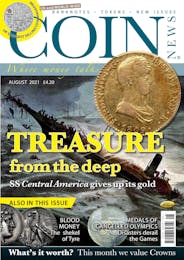
Forging ahead
WE had a very interesting package delivered to our offices last week—a very generous reader sent us a silver 1oz “Liberty Dollar”. Sadly the gift was not quite as it seemed and the reader had pre-warned us the coin was on its way. Why had we been sent it? Quite simply because we wanted to see just how good this forgery was, for yes, it was as you’ve probably guessed, completely fake.
Fake coins are nothing new, counterfeits and forgeries have been in existence for centuries and indeed it is probably because of forgers that the first coins were born—had unscrupulous people not tried to pass off lumps of base metal as electrum King Alyattes of Lydia might not have felt the need to stamp his mark of the lion on the real electrum to enable traders to accept it in good faith. Every collector will have come across a forgery at some point in their life—even if just one of those ridiculous gold coloured lumps of lead that people were passing off as £1 coins before the 12 sided rethink—and it’s very depressing if it ends up costing you serious money. In the past forgeries have been fairly basic and easily spotted if you’re looking, you can perhaps see where a date has been altered, where the cast line is around the rim, where the word “copy” has been skilfully removed and so on, but as technology has got better so too have the fakes and so, once again, we must tell our readers to be on their guard.
The problem with telling our readers to be aware of what is going on is telling you too much. I know that sounds silly but if we start telling you exactly how this latest bunch of forgeries is packaged, tell you how much the weight is off by, tell you exactly what details to look out for then who’s to say the people making them won’t hear of these errors or tell-tale signs and rectify them? OK, so COIN NEWS might not be high on the reading list in many of the places churning out these fakes but you just never know . . . best instead to simply give you a few basic rules that we should all be living by:
1. Firstly, if it seems too good to be true it probably is—if someone is offering you a coin at way below “book” price ask yourself why?
2. Buy from dealers and auction houses you trust— most dealers and auctioneers have a wealth of experience to call upon and will already have spotted the fake, but if one slips through they’ll almost always apologise and give you your money back if the error is theirs.
3. Learn about your coins—if you’ve been collecting a particular type of coin for a while you’ll be familiar with what to look out for, but if you collect new issues and suddenly want to buy some Athenian owls then learn about them, handle some, look at them, get a feel for them, that makes it much easier to spot a fake.
4. If it “feels” off then walk away— your gut instinct is often a very good indicator of what’s right and wrong, don’t be afraid of turning your back on a coin if it doesn’t feel right.
5. Don’t be afraid to ask for advice—I haven’t met a dealer or collector yet who isn’t more than happy to impart their wisdom and knowledge, they want to help keep the hobby “clean” for everybody—just don’t take advantage, especially of dealers if you aren’t buying from them!
6. Lastly, don’t worry too much—fakes and forgeries really aren’t that common and although they will always be around (indeed they are a sub section of the hobby in their own right with some collectors eagerly seeking them out) that shouldn’t put you off, just always be on guard, especially, it seems if buying 1oz silver dollars right now!
Incidentally, you may like to know (for your compendium of useless information, we all have one), that whilst today we tend to use “counterfeit”, “fake” and “forgery” synonymously, “forgery” originally related to the act of “forging” the metal to make the counterfeits rather than the counterfeits themselves—so now you know!









